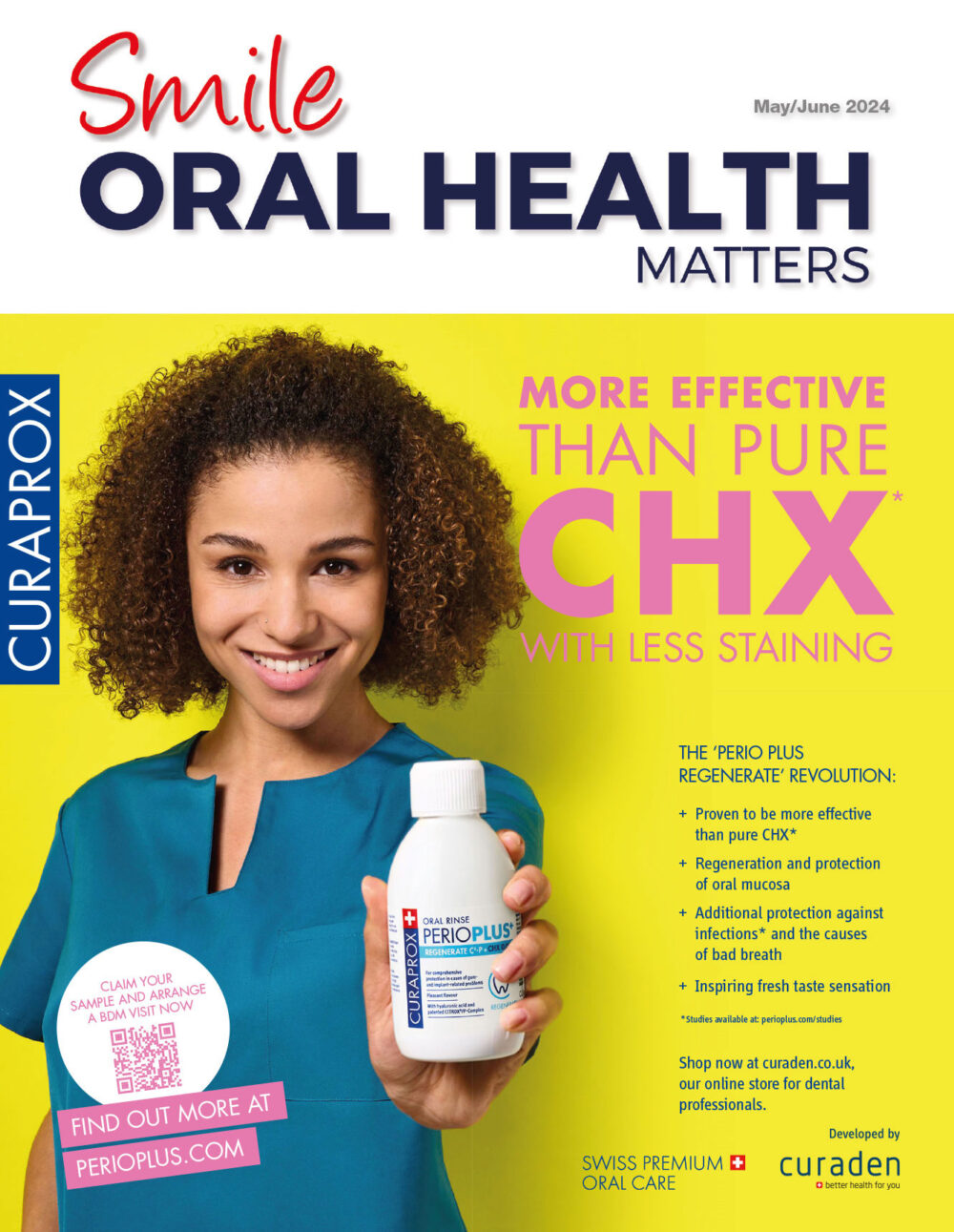
Dr Viraj Patel presents a case requiring different surgical techniques and bone augmentation to deliver a stunning outcome in a timely manner.
Introduction
There are several clinical techniques available to the modern implant dentist. Immediate protocols have grown in popularity and now offer a safe and effective solution in many situations, affording faster treatment times and enhanced aesthetic outcomes. Where required, bone grafting with immediate implant placement delivers excellent results. In particular, socket grafting can reduce the amount of horizontal bone loss and enhance soft tissue stability.[i]
It is also possible to combine techniques, utilising both immediate and delayed placement in the same case. There are even situations that require the placement of two adjacent implants. In this scenario, it is crucial to have sufficient interproximal space to reduce bone loss and help achieve good aesthetics. The gap must be large enough for two standard diameter implants, with ideally 3mm between them[ii] [iii] and a safety zone of 1.5mm between the implants and the neighbouring teeth. That means a minimum gap of approximately 14mm is required to safely and effectively place two implants in adjacent sites – no matter what placement protocol is selected.
The following case demonstrates the placement of two adjacent implants, each requiring a different surgical approach.

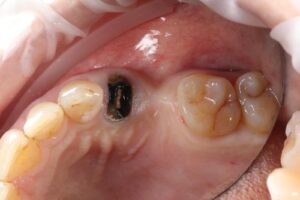
Presentation
A 58-year-old female patient presented looking to improve the aesthetics and function of her dentition. During a consultation with another clinician, she had been offered conventional implant treatment involving the removal of the UL4 – which had root-filled a retained root – and delayed implant placement. The patient was hesitant to proceed in this way due to the predicted  treatment
treatment
time and expense.
Upon presentation, the initial assessment suggested that an immediate implant may be viable for the UL4 site, alongside simultaneous implant placement in the already healed UL5 site.
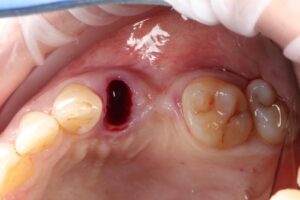
Assessment
A comprehensive clinical assessment was conducted. The patient was generally fit andhealthy, was taking no medication, had no allergies and maintained fair oral hygiene.
The UL5 site, which had been edentulous for approximately 7 years, presented with a substantial depression. This made immediate and simultaneous implant placement even more appropriate for the UL4/5, utilising the bone peaks around the UL4 to create a more favourable UL5 implant position and simultaneous augmentation
Other findings of note were signs of
tooth wear on the UL3 and UL6, although these were periodontally sound
and completely stable.
Options discussed
Aside from no treatment and the conventional delayed implant placement approach already offered to the patient, another option would have been a single implant in the UL5 site and restoration with a cantilever bridge. The existing tooth wear suggested potential parafunction, which would have put considerable pressure on one implant and the resulting restoration, the professional recommendation was two implants at the UL4/5 sites.
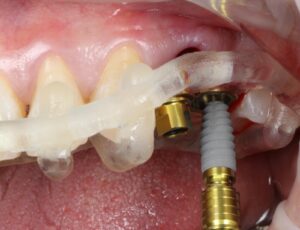
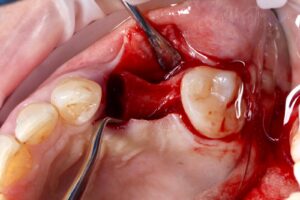
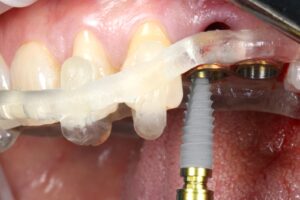
Treatment planning
Approximately 15mm of space was available between the distal of the UR3 and mesial of the UR6, which highlighted the importance of absolute accuracy when positioning the implants. Guided surgery was, therefore, indicated as a way of optimising precision.
Treatment was prosthetically-driven and planned using digital software to determine the ideal implant positions and angles. Immediate Provisionalisation with a non functionally loaded custom healing abutment was to be implemented for the UL4 site, to reduce the impact of any parafunction on the implant during healing. Custom healing abutments are a great tool to support soft tissue in relation to the existing adjacent teeth.
A CBCT and intraoral scans were taken and uploaded to the SMOP portal to design the surgical guide as per the clinical plan. These were 3D printed ahead of the surgical appointment.
Treatment provision
The UL4 root was extracted as atraumatically as possible. The roots were thin and spindly, and needed to be split to be removed safely. They were sectioned ina mesial-distal direction to leave thebuccal and palatal roots separate, reducing the risk of fracture and preserving the interdental and surrounding bone.

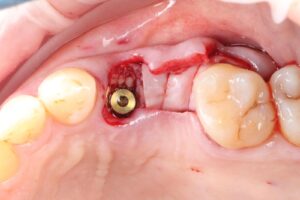
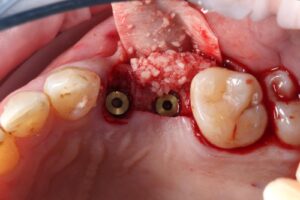
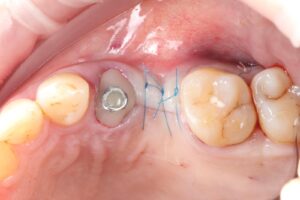
A flap was raised in the UL5 site using a paracrestal incision – vertical incisions were avoided to preserve blood supply to the gingiva, protecting the papilla between the UL6/7 for optimal aesthetic and soft tissue outcomes.
Technically, a flap is not typically needed for many immediate implant cases. However, as the UL5 site needed augmentation and mild atrophy of the ridge was present. The clinician does not advocate 
 flapless procedures for implant placement due to the need to see the underlying ridge and implant following placement.
flapless procedures for implant placement due to the need to see the underlying ridge and implant following placement.
The surgical guide was then placed in the mouth and the manufacturer’s specific drilling sequence followed, increasing the osteotomy in size incrementally.
Two 3.8mm diameter CONELOG Progressive-Line implants were placed through the guide, following theplan precisely. The UL4 implant was longer (11mm) to ensure sufficient apical bone was engaged for primary stability, it was also positioned in the palatal root to ensure good engagement with the bone and better bone to implant contact. A sizable jump gap was noted between the implant and the buccal plate of around 5-6mm. From a biological perspective, the jump gap can be left because the ridge would heal to leave a sufficient buccal plate. However, the literature[iv] shows that grafting reduces the amount of bone resorption post implant placement, which was one of the reasons that augmentation was indicated in this case.
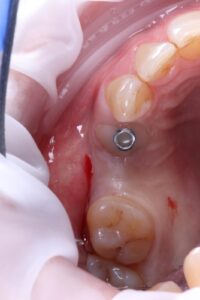


Another predetermined concern was the amount of remaining bone surrounding an implant after placement. There was less than 2mm of residual bone buccal to the UL5 site once the implant was placed. Alberto Monje et al. (2023)[v] showed that thin buccal bone at the implant site increases the risk of major dimensional changes, this can have direct implications on the aesthetics and functional outcomes.
Consequently, the bone was contour-augmented, using MinerOss Blend (BioHorizons Camlog), which provides a good combination of cortical and cancellous bone for efficient bone turnover and also maintains graft stability in the healing phase. The graft was held in place with a collagen membrane stabilised using resorbable sutures. The custom healing abutment is then placed and torqued (10Ncm) into the UL4 implant before the wound is approximated and sutured using a non-resorbable 6-0 Prolene suture.
An x-ray was taken immediately post-operatively to confirm that the temporary cylinder was seated correctly and wasn’t catching on the socket walls. This image also provided a reference for the custom healing abutment position and ensured that the bone graft material added to the jump gaps wasn’t preventing this abutment from fully seating.
Review and reflections
The implant in the UL5 was uncovered 3 months later to reveal healthy tissues. Three weeks later the final scan was taken (using trios intra-oral scanner) for the fabrication of the definitive crowns. On the day of crown fits both abutments were removed and the crowns seated. Due to the UL4 site having a custom healing abutment, which had been supporting our ideal emergence profile, it was much easier to engage this restoration and seat within the already moulded soft tissues. With regards to the UL5 there was some blanching around the buccal aspect of the crown due to the use of a generic abutment, which does not offer any resemblance to the ideal emergence profile for the final restoration. Regardless good prosthetic positioning had been achieved to allow for screw-retained restorations in both implants. The final restorations were fitted as single unit layered zirconia crowns on titanium bases. The patient was delighted with the results.
Upon reflection of this case, a custom healing abutment may have delivered better soft tissue contouring than the generic abutment on the UL5. Healing may have taken longer, but it would have been easily tolerated by the patient and may have resulted in a better biological result with optimised aesthetics.


With regards to the products selected, the CONELOG Progressive implant 3.8mm is my go-to for premolar sites. The implant is versatile in its clinical application, suitable for use in healed ridges and fresh sockets, providing good stability for delayed and immediate implant placement protocols. It’s an all-in-one implant for me and I love using it. The implant connection is also great – you almost get a cold weld on the conical connection, which affords confidence that customhealing abutments will remain stable during the healing phase.
One of the main reasons I choose to work with BioHorizons Camlog, aside from the quality of the products, is that the customer service is incredible. I have complete access to the local rep, the regional and area managers when needed. There is also a great community and network of clinicians using their products, which allows me to discuss cases with friends and colleagues.
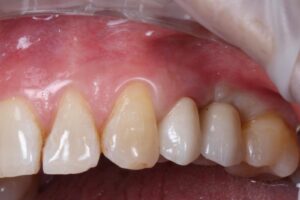


For product information from BioHorizons Camlog, please visit https://theimplanthub.com/
Author bio: Dr Viraj Patel
BDS Honours (Cardiff)
MJDF (RCS England)
Certificate in Advanced Implant Dentistry (New York University)
PgCert Clinical Teaching (RCGP)
Clinical Implant Diplomate (ICOI)
Having qualified as a dentist in 2012, Viraj has set out to gain the necessary experience to help become one of the lead Implantologists in the UK for the future.
He underwent hospital training in Maxillofacial and Oral surgery in 2014 and has since attended multiple Dental Implant courses within the UK. In 2018 his passion for implants led him to New York City, where he enrolled for 2 years at New York University (NYU), on the renowned Advanced Implant Dentistry Program.
Since moving back to the UK, on completion of the Program, in 2020 he has been working as a dental implantologist in private practices across London.
Along the way he has been awarded multiple accolades including “ITI Future Star” prize by the International Team of Implantology in 2021, he received prizes for “the Best Young Implant dentist” in the UK 2022, 2023 & 2024. On the international stage he has also won the “European Prize for Clinical Innovations in Implant Dentistry” as well as winning the award for the best Clinical Case for the “Complex Implant treatment” Category and single implant tooth category at the prestigious “Clinical Dentistry Awards” years 2023 and 2024. He is a key opinion leader for some of the leading implant companies within the UK including (Biohorizons, Geistlich & Zimvie) and is now lecturing and presenting internationally.
He also sits on the board of notable Junior Implant Organisation committees including The NextGen Committee with the Association for Dental Implantology (ADI) UK and the Junior Committee for the European Association of Osseointegration (EAO).
His passion within implant dentistry lies in Regenerative Implant dentistry including Bone and Soft tissue Augmentation.
[i] Seyssens L, Eeckhout C, Cosyn J. Immediate implant placement with or without socket grafting: A systematic review and meta-analysis. Clin Implant Dent Relat Res. 2022 Jun;24(3):339-351. doi: 10.1111/cid.13079. Epub 2022 Mar 21. PMID: 35313067.
[ii] Ramanauskaite A, Roccuzzo A, Schwarz F. A systematic review on the influence of the horizontal distance between two adjacent implants inserted in the anterior maxilla on the inter-implant mucosa fill. Clin Oral Impl Res. 2018; 29(Suppl. 15): 62–70. https://doi.org/10.1111/clr.13103
[iii] Degidi, M., Novaes, A.B., Jr., Nardi, D. and Piattelli, A. (2008), Outcome Analysis of Immediately Placed, Immediately Restored Implants in the Esthetic Area: The Clinical Relevance of Different Interimplant Distances. Journal of Periodontology, 79: 1056-1061. https://doi.org/10.1902/jop.2008.070534
[iv] Liñares A, Dopico J, Magrin G, Blanco J. Critical review on bone grafting during immediate implant placement. Periodontol 2000. 2023; 93: 309-326. doi:10.1111/prd.12516
[v] Monje, A., Roccuzzo, A., Buser, D., & Wang, H.-L. (2023). Influence of buccal bone wall thickness on the peri-implant hard and soft tissue dimensional changes: A systematic review. Clinical Oral Implants Research, 34, 157–176. https://doi.org/10.1111/clr.14029











